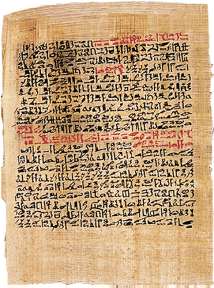

The ‘channel theory’ prevalent at that time, in which the unimpeded flow of bodily fluids was considered a fundamental prerequisite for health, may likely be regarded as precursor of ancient Greek humoral pathology. Even back then, physicians sought to assess inflammatory processes with respect to their cardinal features, implement graded wound therapy, and treat diseases with allopathic drugs.
Ebers papyrus author skin#
Apart from hygienic aspects, skin and hair disorders, the treatment of acute and chronic wounds and injuries as well as cosmetic procedures took on an important role.

Ebers papyrus author manual#
Taking a medical history, performing a thorough manual examination, and assessing clinical findings constituted key components in establishing a diagnosis. Considering the times, the spectrum of diseases treated as well as the range of conservative and surgical treatment methods was truly astounding. What did Greek and Roman physicians learn from their Egyptian counterparts? Of the medical papyri discovered to date, the largest and most significant – the Ebers papyrus and the Smith papyrus – originate from the beginning of the New Kingdom, however, they were – at least in part – already written during the Old Kingdom. By contrast Diabetes: From the Ebers Papyrus to Stem Cell Technology explores and analyses all reported aspects of diabetes from 1536 BC to present day.Although ancient Greek and Roman medicine is generally considered the origin of European medicine, there is evidence in ancient Egyptian texts suggesting a precursor role of ancient Egyptian medicine in this regard. Whilst there are a number of titles available that explore aspects of diabetes such as the discovery of insulin, or the pathophysiology and treatment of the condition, a complete history of diabetes from the first recognition of symptoms similar to those of Type 1 diabetes in ancient Egyptian times to present day technological developments has been overlooked. Because one million people per year are currently diagnosed with Type 2 diabetes in the USA alone and the condition is recognised by the World Health Organisation as a dangerously growing epidemic currently affecting 350 million people around the world, it has a definite international significance. This title will be of interest to anyone with diabetes carers, family and friends of those individuals and also medical historians. This book results from research over the past four years exploring available literature concerning diabetes in ancient times, through the middle ages, scientific period, the discovery of insulin, and developments and advances in understanding as they occurred.

Reversal of this condition, which may go undiagnosed for up to 12 years before it is recognised, is potentially possible in as many as ninety per cent of cases with regular exercise and by adopting a diet that is not rich is refined carbohydrates. Transplant options are also investigated, as is the ever-increasing epidemic of Type 2 diabetes around the world. The use of cutting-edge technology to treat and manage Type 1 diabetes is examined, both objectively and subjectively, from the author's own experience of using these therapies and devices. This work investigates the growth of diabetes-based knowledge, leading to the use of modern treatment options and medical breakthroughs in the search for a cure. This book explores major themes such as the discovery of insulin in 1921 the ultimate recognition that high blood glucose levels lead to secondary chronic and devastating complications such as blindness and serious nerve damage, heart disease, stroke and kidney failure - and many lesser known complications of the condition - including how these may be stabilised and in many cases improved. Diabetes: From the Ebers Papyrus to Stem Cell Technology is a complete history of the disease from the first recognition of symptoms in ancient Egypt in 1536 BC to modern times when technology and surgical options became available to treat and manage the condition.


 0 kommentar(er)
0 kommentar(er)
